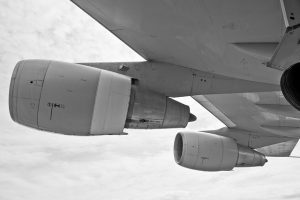
Ever wonder why so many commercial jets have their engines mounted under their wings? Wing-mounted engines are common in the commercial aviation industry. With the exception of small and mid-size jets, most commercial jets have wing-mounted engines. They offer several key benefits over tail-mounted engines.
#1) Weight Distribution
Wing-mounted engines help with weight distribution. To say that jet engines are heavy would be an understatement. Depending on the size and type, they can weigh anywhere from 2,000 to 20,000 pounds — sometimes even more. Wing-mounted engines provide better weight distribution by spreading this load across both sides of the airplane, whereas tail-mounted engines focus this load on the tail assembly.
#2) Fuel Efficiency
Airplanes with wing-mounted engines are typically more fuel efficient than those with tail-mounted engines. The wings are already designed to withstand the weight and stress of flight, making it an ideal mounting location for engines. The tail assembly, on the other hand, must be heavily modified so that it can support engines, resulting in a heavier weight for the airplane, which translates into poorer fuel efficiency.
#3) Noise
Another benefit of wing-mounted engines is less noise. Jet engines are loud. When cruising, a typical jet engine is about 140 decibel (dB). The farther away a jet engine is from the fuselage and cabin, though, the lower the perceived dB by passengers. Wing-mounted engines, of course, are farther away than tail-mounted engines, allowing for a quieter and more peaceful flight experience for passengers.
#4) Fuel Feeding
Wing-mounted engines allow for gravity-based fuel feeding. As the name suggests, this involves the use of gravity to feed fuel to an airplane’s engines. Most airplanes have fuel pumps, which can fail and starve the engines of critically important fuel. With wing-mounted engines, gravity can continue to supply the airplane’s engines with fuel in the event of pump failure.
#5) Maintenance
Finally, wing-mounted engines are easier to maintain than their tail-mounted counterparts. They are typically closer to the ground where mechanics can access them more easily. Engine-mounted wings often use a simpler design than tail-mounted counterparts, and because they are so common, mechanics are often familiar with them. For these reasons, wing-mounted engines are easier to maintain.
In Conclusion
Wing-mounted engines have earned their place in the commercial aviation industry. They balance the airplane’s weight more effectively, improve fuel efficiency, reduce cabin noise, allow for gravity-based fuel feeding and simplify the process of maintenance and repairs.



